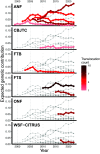Translocations contribute to population rescue in an imperiled woodpecker
- PMID: 40720647
- PMCID: PMC12337267
- DOI: 10.1073/pnas.2410946122
Translocations contribute to population rescue in an imperiled woodpecker
Abstract
Anthropogenic destruction and fragmentation of habitat restrict many species to small, isolated populations, which often experience high extirpation risk. Restoring connectivity through translocations is one approach for mitigating the demographic and genetic perils faced by small populations. However, translocation interventions often lack substantial postrelease monitoring, and thus important information including the performance of translocated individuals, the long-term impacts on the recipient population, and the extent to which management objectives are fulfilled over time are often poorly known. Here, we examined the establishment dynamics and long-term outcomes of translocations from multiple donor populations into an intensively monitored population of the federally threatened red-cockaded woodpecker. We found evidence that translocations contributed to population growth and led to genetic admixture within the population. The translocated birds provided direct demographic benefits through high rates of establishment, breeding, and survival. We found that the survival and lifetime reproductive success of individuals were positively related to their amount of translocation ancestry, indicating that demographic benefits extended beyond the direct performances of the translocated birds. The translocations diversified the population's genetic composition with the ancestry of most individuals in the latter years of the study deriving from multiple translocation donor populations. We found marked heterogeneity in the genetic contributions of translocated individuals and cohorts, leading to disproportionate representation of certain lineages. Encouragingly, despite some accumulation of inbreeding during the study, the translocations thus far have not substantially contributed to inbreeding. Our findings illustrate in precise detail how translocations can be an effective approach for managing imperiled taxa.
Keywords: conservation; demographic rescue; pedigrees; translocations.
Conflict of interest statement
Competing interests statement:The authors declare no competing interest.
Figures





Similar articles
-
Falls prevention interventions for community-dwelling older adults: systematic review and meta-analysis of benefits, harms, and patient values and preferences.Syst Rev. 2024 Nov 26;13(1):289. doi: 10.1186/s13643-024-02681-3. Syst Rev. 2024. PMID: 39593159 Free PMC article.
-
Long-Term Noninvasive Genetic Monitoring Guides Recovery of the Endangered Columbia Basin Pygmy Rabbits (Brachylagus idahoensis).Genes (Basel). 2025 Aug 13;16(8):956. doi: 10.3390/genes16080956. Genes (Basel). 2025. PMID: 40870004 Free PMC article.
-
Community views on mass drug administration for soil-transmitted helminths: a qualitative evidence synthesis.Cochrane Database Syst Rev. 2025 Jun 20;6(6):CD015794. doi: 10.1002/14651858.CD015794.pub2. Cochrane Database Syst Rev. 2025. PMID: 40539472 Review.
-
Short-Term Memory Impairment.2024 Jun 8. In: StatPearls [Internet]. Treasure Island (FL): StatPearls Publishing; 2025 Jan–. 2024 Jun 8. In: StatPearls [Internet]. Treasure Island (FL): StatPearls Publishing; 2025 Jan–. PMID: 31424720 Free Books & Documents.
-
Interventions to improve safe and effective medicines use by consumers: an overview of systematic reviews.Cochrane Database Syst Rev. 2014 Apr 29;2014(4):CD007768. doi: 10.1002/14651858.CD007768.pub3. Cochrane Database Syst Rev. 2014. PMID: 24777444 Free PMC article.
Cited by
-
Synergies between speciation and conservation science yield novel insights for mitigating the biodiversity crisis of the Anthropocene.Proc Natl Acad Sci U S A. 2025 Aug 5;122(31):e2500713122. doi: 10.1073/pnas.2500713122. Epub 2025 Jul 28. Proc Natl Acad Sci U S A. 2025. PMID: 40720642 Free PMC article. No abstract available.
References
-
- Scott J. M., et al. , Recovery of imperiled species under the endangered species act: The need for a new approach. Front. Ecol. Environ. 3, 383–389 (2005).
-
- Scott J. M., Goble D. D., Haines A. M., Wiens J. A., Neel M. C., Conservation-reliant species and the future of conservation. Conserv. Lett. 3, 91–97 (2010).
-
- Goble D. D., Wiens J. A., Scott J. M., Male T. D., Hall J. A., Conservation-reliant species. BioScience 62, 869–873 (2012).
-
- Wilcove D. S., Rothstein D., Dubow J., Phillips A., Losos E., Quantifying threats to imperiled species in the united states assessing the relative importance of habitat destruction, alien species, pollution, overexploitation, and disease. BioScience 48, 607–615 (1998).
MeSH terms
LinkOut - more resources
Full Text Sources

